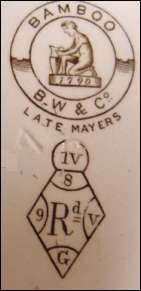"The extensive works at Dale Hall
(or Dale Hole, as it used to be written), founded in 1790
originally belonged to Joseph Stubbs - a successful manufacturer
of earthenware during the 1822-5 period, who having retired from
business, died in 1836. He was succeeded in about 1843 by
Messrs. Thomas, John & Joshua Mayer, who from 1855 traded as
Mayer Brothers & Elliot, and from them the works passed through
the firms of Mayer & Elliot, Liddle, Elliot, & Co., Bates,
Elliot & Co., Bates, Walker & Co., and Bates, Gildea & Walker to
the firm of Gildea & Walker during the 1881-6 period."
The marks of
Messrs. Mayer were T.J.&J. MAYER; MAYER BROS, etc. Those of the
later firms were BATES, WALKER & Co.
PATENTEES (or other successive changes), on an oval ribbon, with
date, etc., of registration inside; and a nude figure kneeling
and holding a ewer in front of him, on a tablet with the date
1790.
This device was
introduced in a variety of ways, with the initials B.W. & CO.,
B.G. & W., or G. & WĄ LATE MAYERS, and the name of
the pattern, etc. On some, the device is surrounded by a
circular ribbon, on others by a triangular one.
Messrs. Gildea & Walker continued to 1886. The Dale Hall Works
were subsequently worked by Keeling & Co. (Ltd.) from 1886 to
1936. They used the above mark with the initials K & Co. B."
Jewitt's "Ceramic Art of Great
Britain 1800-1900",

Bates, Walker & Co
BW & Co
1875-78
"BAMBOO" is the pattern name
![]()
![]()
![]()